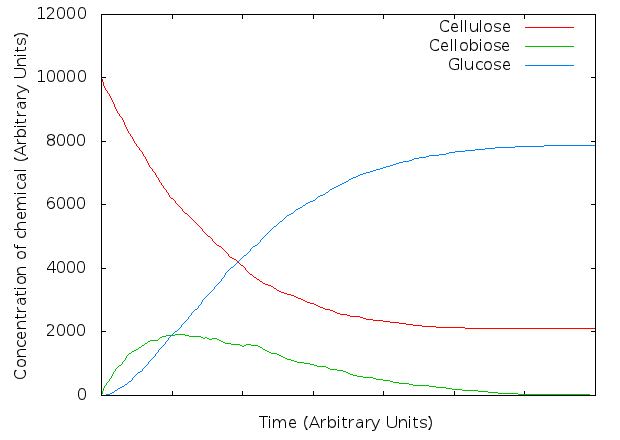Team:Edinburgh/Cellulases (Kappa model)
From 2011.igem.org
Kappa
Kappa is a stochastic, agent-based language for simulating interactions in (mostly) biological systems. It has been used by several iGEM teams before, most notably by Team Edinburgh 2010, who won a Best Model Prize for it.
Advantages of Kappa:
- easy to learn - you can summarise the whole language on one page
- no need for knowing mathematical formulae (ODEs) - the sophisticated code does that for you
- the models are relatively easy and quick to develop
- there exist some graphical tools to aid creation of models - e.g. RuleBase
Kappa represents the world in terms of agents. Agents in Kappa can have states, and can be linked to one another by bonds. Reactions are represented as creation/deletion of agents/bonds.
We thought that a neat model would represent cellulose as a long fibre of glucoses linked together:
Then, Endoglucanase would cut Cellulose in places where it can
We developed our first, non-synergistic model in Kappa. A preliminary model showed similar graphs to those in Kadam, Rydholm & McMillan (2004). However, after closer examination, the model made us think of one problem - glucose trimers.
Glucose trimers
The first slightly unanticipated result of our simulations was that, depending on how the model is set up, trimers of glucose can appear. If none of the (simulated) enzymes can degrade this, it will be one of the terminal products.
The following graph shows concentrations of glucose, cellobiose, and "cellulose" (which is defined as any glucose chain of length greater than 2) in a simple simulation where all three cellulase types are present but none is capable of degrading the trimer... at the end, all of the so called "cellulose" is composed of these trimers.
This immediately led us to the question of whether any of our three enzymes (Cellulomonas fimi endoglucanase, exoglucanase, and β-glucosidase) are in fact capable of degrading the trimer...
References
- Kadam, KL, Rydholm, EC, McMillan JD (2004) Development and Validation of a Kinetic Model for Enzymatic Saccharification of Lignocellulosic Biomass. Biotechnology Progress Vol. 20, Issue 3: 698–705, (doi: 10.1021/bp034316x).
 "
"

